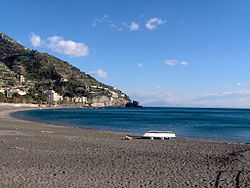You can help expand this article with text translated from the corresponding article in Italian. (January 2022)Click [show] for important translation instructions.
|
Maiori | |
|---|---|
| Comune di Maiori | |
 | |
 Maiori within the Province of Salerno | |
| Coordinates: 40°39′N14°39′E / 40.650°N 14.650°E | |
| Country | Italy |
| Region | Campania |
| Province | Salerno (SA) |
| Frazioni | Erchie, Ponteprimario, San Pietro, Santa Maria delle Grazie, Vecite |
| Government | |
| • Mayor | Antonio Capone |
| Area | |
• Total | 16.67 km2 (6.44 sq mi) |
| Elevation | 5 m (16 ft) |
| Population (30 September 2017) [2] | |
• Total | 5,604 |
| • Density | 340/km2 (870/sq mi) |
| Demonym | Maioresi |
| Time zone | UTC+1 (CET) |
| • Summer (DST) | UTC+2 (CEST) |
| Postal code | 84010 |
| Dialing code | 089 |
| Patron saint | Santa Maria a Mare |
| Saint day | 15 August |
| Website | Official website |
| Part of | Costiera Amalfitana |
| Criteria | Cultural: (ii)(iv) |
| Reference | 830 |
| Inscription | 1997 (21st Session) |
| Area | 11,206 ha (27,690 acres) |
| Buffer zone | 11,857 ha (29,300 acres) |
Maiori (originally in Latin: Rheginna Maior) is a town and comune on the Amalfi coast in the province of Salerno (Campania, Italy). It has been a popular tourist resort since Roman times, with the longest unbroken stretch of beach on the Amalfi coastline.





